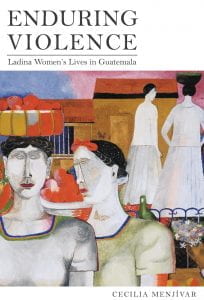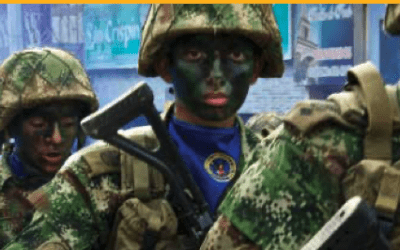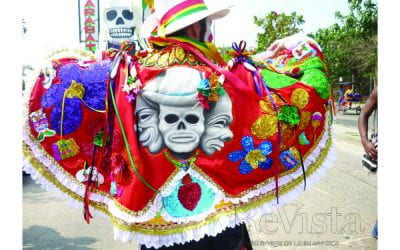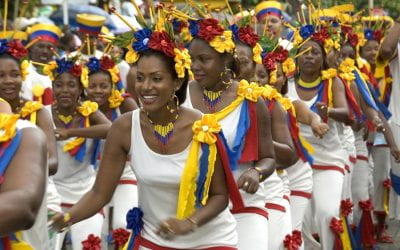A Review of Enduring Violence: Ladina Women’s Lives in Guatemala
Is There a “Post-Conflict” in Guatemala?

Enduring Violence: Ladina Women’s Lives in Guatemala By Cecilia Menjívar Berkeley: University of California Press, 2011
When I was a graduate student in Latin American history at Berkeley in the 1980s, the words “violence” and “Guatemala” seemed inextricably linked. We devoured newsletters from the Guatemala News and Information Bureau, participated in house meetings where refugees described the terror in the highlands, watched innumerable videos and protested U.S. support for counterinsurgency there as well as in El Salvador and Nicaragua.
Then the books started to come out, starting perhaps with Rigoberta Menchú’s testimony in 1984. Their titles reflected the horror: Refugees of a Hidden War (1987), Harvest of Violence (1988), Guatemala: Eternal Spring, Eternal Tyranny (1988), The Battle for Guatemala: Rebels, Death Squads, and US Power (1991), Massacres in the Jungle (1993). You might think that authors would run out of titles that did justice to the carnage, but no, they kept coming: Trade Unionists against Terror (1994), Unfinished Conquest: The Guatemalan Tragedy (1995), Testimony: Death of a Guatemalan Village (1995), The Guatemalan Military Project: A Violence Called Democracy (1999), Guatemala: Never Again! (1999), The Blood of Guatemala (1999), The Last Colonial Massacre (2004), Buried Secrets (2004), Silence on the Mountain: Stories of Terror, Betrayal, and Forgetting in Guatemala, Paradise in Ashes (2005), The Art of Political Murder: Who Killed the Bishop? (2007).
Most of these works logically focused on what Guatemala’s international Truth Commission deemed a “genocide” against the country’s indigenous Mayan population. The signing of the Peace Accords in 1996 was supposed to signal an end to the violence and terror, as optimistically predicted in the title of the Archdiocese report released in 1998 (Never Again!). The gruesome murder of the report’s chief author, Bishop Juan Gerardi, on the day after its release, made it clear that the optimism was premature.
Cecilia Menjívar’s book asks us to think about the violence in a different way. Instead of focusing on the Mayan highlands, she chose a research site in lowland eastern Guatemala, among ladina (non-indigenous) women. Instead of looking at the overt violence of the war, with its massacres, torture, disappearance and murder, she examines the violence of everyday life in the post-war 21st century. It’s a violence that goes unrecorded and unacknowledged, a violence so embedded in social norms that it goes mostly unrecognized even by its victims: they view their suffering as too normal to merit comment. The book shows how years after the war’s end, echoes of its large-scale violence continue to blight the lives of Guatemala’s most vulnerable, especially the poor, and especially women.
The violence she focuses on is multisided, emanating from “multiple systems of oppression and exclusion” (3). While initiated by individuals, the underlying causes are “extrapersonal forces” (4). She describes it as “veiled violence in forms of social control of women that result in devaluation, humiliation, a lowered gaze, the kind of violence that does not shock the observer because it is part of the everyday but that is deeply connected to the more noticeable acts that inflict physical injury because both kinds of violence arise from the same structures” (4).
This violence is embedded in a national and global order that imposes poverty, lack of resources, and lack of access to decent work, education, and social services—what she terms “structural violence” (29). Compounding this is the state terror that characterized Guatemala in the 1980s and has been succeeded by impunity and a depoliticized criminal violence that mimics it (37). Underlying these is “symbolic violence,” the mental constructs that justify and naturalize violence, suffering, and inequality, explaining them as the “natural order of things.” “Gender violence”—the belief system that justifies male dominance and control of women—contributes to “gendered violence”—acts of violence carried out specifically against women (46).
Through meticulous interviews Menjívar examines various areas of women’s lives, including marriage and intimate relationships, children, work and religion, and shows in excruciating detail how poverty and lack of resources compound social norms that denigrate and discount women to create a context in which pain and suffering are normalized. In their intimate relationships, women confront control, humiliation, alcohol, physical violence and infidelity. When raising children, they face a lack of access to basic needs, infant and child death, constant scrutiny and criticism for their care of their children, and unending blame for failing to meet the standards of their partners, in-laws or health providers. Decent work is practically non-existent, and women’s work in and outside the home is denigrated. The church—like the other sources of support and solace that the author investigates—generally encourages acceptance of the social order rather than questioning it. This naturalization of violence, embedded in social structures even if embodied in individuals, forms the core of Menjívar’s analysis.
As I was reading Enduring Violence, Malala Yousafzai, a 16-year-old Pakistani girl, surged into the headlines for her courageous advocacy of girls’ education after an almost-successful assassination attempt by the Taliban. The fact that her story is politically convenient for the U.S. government and others fighting the Taliban does not detract from her courage. But Menjívar’s book reminds us that legal prohibitions enforced by overt violence are not the only way that girls are deprived of education. Out of the international limelight, and unremarked even locally, large numbers of girls and women in rural Guatemala do not attend school at all or attend only a few years of primary school. “Not attending school or abandoning school, for girls especially, was an act so embedded in the ‘order of things’ that most did not blink an eye when the subject was brought up for discussion” (176). As one of her informants explained, “As uno de pobre [a poor person], one doesn’t think of these things, like school. One knows as a poor person that these things are for others, but not for us” (178-79).
Menjívar’s arguments brought to mind Cuban singer-songwriter Silvio Rodríguez’s 1969 song “The Family, Private Property, and Love.”
Una buena muchacha de casa decente no puede salir
¿Qué diría la gente el domingo en la misa si saben de ti?
¿Qué dirían los amigos, los viejos vecinos que vienen aquí?
¿Qué dirían las ventanas, tu madre y su hermana, y todos los siglos del colonialismo español que no en balde te han hecho cobarde?
[A good girl from a decent home can’t go out
What would people say at mass on Sunday if they find out about you?
What would the friends say, the old neighbors who come here?
What would the windows say, your mother and her sister, and all those centuries of Spanish colonialism that not in vain have made you a coward?]
In the song, as in Menjívar’s book, the weight of gossip and shame hangs over women and controls their behavior. The song’s title, and the reference to the impact of centuries of Spanish colonialism (in Cuba until 1898), suggest the same point that Menjívar emphasizes, that there is a political economy at work here (11, 62, 180). “Taking gossip out of context… may present this practice as the product of culture or tradition, unrelated to violence in the way I am arguing it is linked,” she writes. “Gossip becomes a form of violence because it is a weapon of social control and a source of humiliation, pain, and affliction in women’s lives” (77).
Disturbingly, the author ends each chapter, and the book as a whole, with a section on the sources of support, connection, and sociability that women rely on to endure the violence of their lives. These include their relatives, other women, co-workers and the church. In each case, Menjívar draws a complex picture in which the very support that women seek, provide and receive simultaneously serves to naturalize and sustain the ideologies that underlie the violence. Women console each other by saying “men are like that” or “that’s the way it is around here.”
“Although women found solace and comfort in the people who were close to them, at the same time the actions of these individuals often reinforced the structures of inequality and violence in which the women lived. While a mother’s words might have helped to soothe her daughter’s pain, they also encouraged the daughter to continue to endure a husband’s abuse” (124). Similarly, the church provided a space “where suffering is normalized.” “In the absence of actions that would lead to genuine transformation in the women’s lives and make women realize that avenues for change were possible, the comfort and solace provided by the churches served mostly to sustain various unequal structures, to internalize and to naturalize them” (214).
Despite Menjívar’s qualifications about redeeming moments in the lives of the women she interviewed, I finished the book feeling an unbearable weight of sadness. Violence and suffering in Guatemala have deep roots and branches, and will not be uprooted any time soon.
Spring 2014, Volume XIII, Number 3
Aviva Chomsky is professor of history and coordinator of Latin American Studies at Salem State University.
Related Articles
Festival and Massacre
Festivals are privileged spaces to help us understand the meaning of community. They are a special way of presenting historical narratives, bringing…
Fiesta and Identity
English + Español
In Barranquilla the days of Carnival begin early. From the first hours of the day—already confused with the last hours of the night—the smells of celebration are in the air. The streets…
Fiestas: Editor’s Letter
At the Oruro Carnival, a few hours from La Paz, the heavy-set blue-skirted women swirl past me in a dizzying burst of color and enviable grace. The trumpeters, some with exotically dyed hair, blare not too far behind. I remember that as a young man President Evo Morales had been a trumpeter in this very carnival.




